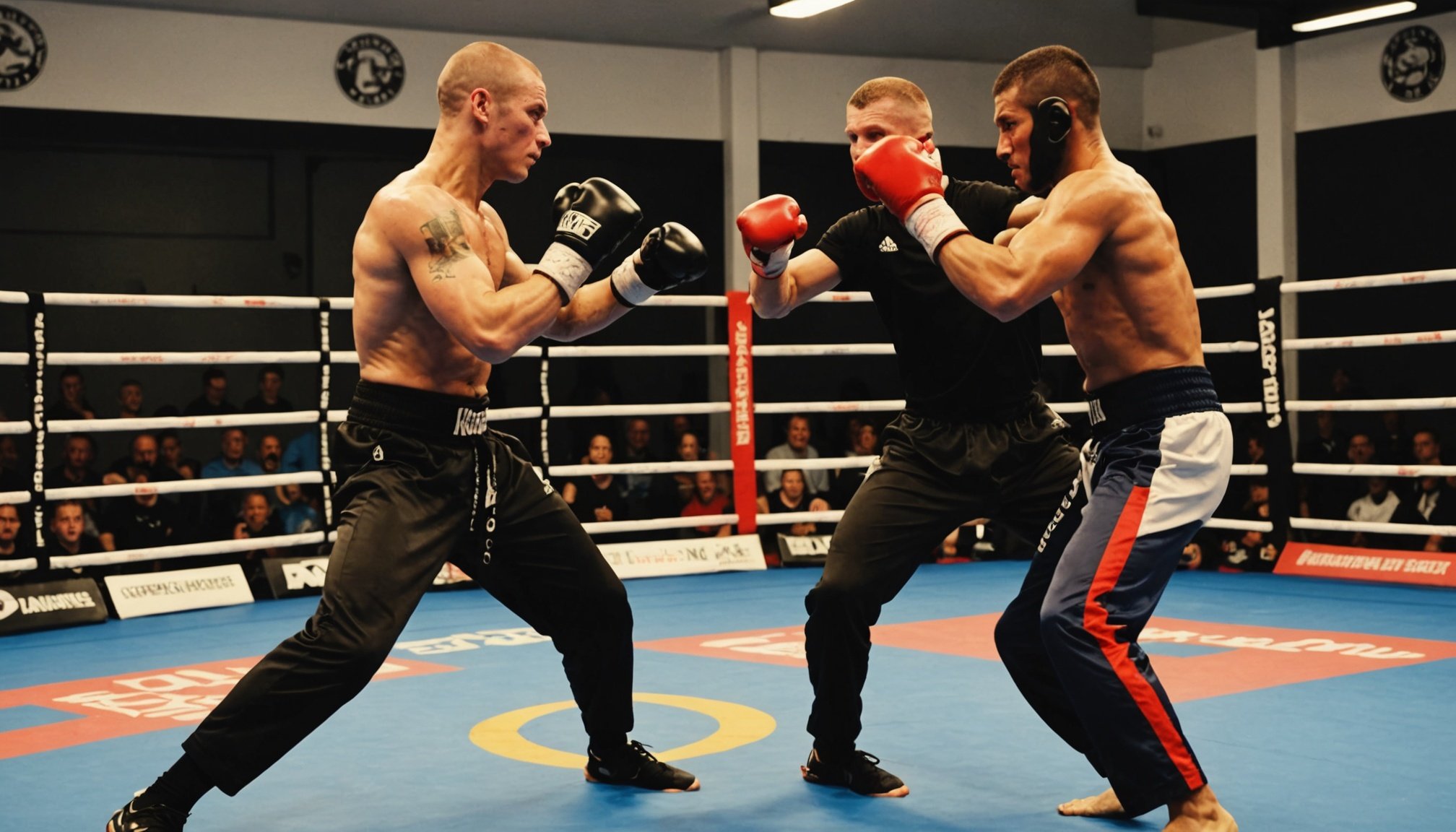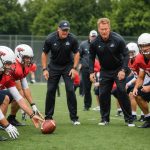Advanced Training Techniques for Kickboxers
The landscape of kickboxing training has evolved, embracing innovative training methods to boost performance enhancement dramatically. At the forefront are cutting-edge training regimens that champion precision, endurance, and technique.
Exploring Cutting-Edge Training Regimens
Top UK kickboxers deploy a blend of traditional skills and modern methodologies. This fresh approach includes diversified workout programs essential for holistic improvement. Notably, cross-training enhances both cardiovascular and muscular capacity, fortifying the fighters’ stamina and agility.
Also read : Enhancing recovery in uk combat sports: the essential importance of heart rate variability
The Role of Sparring and Drills
Sparring remains a pivotal element, enabling athletes to translate learned skills into practical, real-world application. This practical engagement sharpens tactical brilliance—it’s sparring where reflexes are honed. Drills complement sparring by focusing on precision and technique, offering repetition that’s crucial for muscle memory development.
Importance of Incorporating Technology
Integrating technology in training sessions is an emerging trend that is revolutionising the sport. Tools like wearable tech provide vital data on an athlete’s performance, tracking aspects such as speed, balance, and power output. These insights enable bespoke adjustments, optimising the training impact and ensuring that kickboxers perform at their peak when it counts most.
Also to discover : Harnessing mindfulness for peak performance: elevating uk combat sports athletes” competitive edge
Emphasising balanced innovation, these methods collectively advance skill levels, keeping athletes ahead of their competition.
Innovative Tactical Approaches
In the dynamic world of kickboxing, refining tactical strategies is crucial for elevating match performance. Understanding and employing the right techniques can significantly improve a fighter’s prowess and results in the ring.
Utilizing Feints and Fakes
Feints and fakes are essential components of a successful strategy. Their main purpose is to mislead an opponent, making them react prematurely. By exploiting these openings, fighters can strike effectively when their opponent’s guard is down. It’s not just about deception but anticipating the opponent’s likely responses to create advantageous situations.
Counter-Attack Techniques
Counter-attack techniques form the backbone of many defensive strategies. These not only protect a fighter but turn defence into an opportunity to seize momentum. The key lies in discerning an opponent’s patterns, and timing, to intercept and exploit their advances. Developing such defensive strategies ensures resilience against aggressive fighters, turning defensive postures into offensive opportunities.
Angle and Distance Management
Managing angles and maintaining the right distance can dictate the flow of a match. The significance of angles is evident—they allow fighters to strike while minimising exposure. By controlling distance, a fighter can decide whether to engage or avoid attacks, shaping the match’s pace and direction. The understanding of angles and precise movements is imperative for tactical supremacy.
Mental Conditioning for Competitors
When submerged in the realm of sports psychology, mental resilience emerges as a powerful ally for competitors. To excel under pressure, athletes must employ effective techniques to foster mental toughness. One such technique involves visualization strategies. Athletes are encouraged to mentally rehearse scenarios, envisioning themselves successfully executing plays or overcoming challenges. This practice helps imprint successful outcomes in their minds and enhances performance during real events.
Another critical aspect involves goal setting. Setting clear, achievable goals provides competitors with direction and motivation, encouraging a focus on incremental progress. Athletes should regularly engage in self-reflection, evaluating their performance and identifying areas for improvement. This introspective practice aids in recognizing strengths and pinpointing weaknesses, contributing to continuous growth.
Developing a strong mental foundation is akin to building resilience. Under pressure, an athlete’s preparedness and mindset can profoundly impact their ability to push through challenges. Techniques such as maintaining a positive inner dialogue and adopting stress management strategies are essential in cultivating a competitor’s mental resilience. Ultimately, mastering these aspects of sports psychology empowers athletes to navigate the psychological complexities of competitive environments, optimizing their performance both physically and mentally.
Nutrition Strategies for Optimal Performance
To achieve the best results in athletic endeavors, a robust understanding of athlete nutrition is essential. By tailoring one’s diet to meet specific performance needs, athletes can enhance both their energy levels and recovery rates.
Macronutrient Balance
A balanced intake of macronutrients is crucial for dietary performance. Carbohydrates serve as the primary energy source, especially during intense workouts. Proteins are vital for muscle repair and growth, while healthy fats provide a sustained energy release. Striking the right balance ensures that athletes maintain stamina during training and recovery periods.
Pre- and Post-Workout Nutrition
The timing and composition of meals around workouts play a significant role. Consuming a blend of carbohydrates and proteins prior to exercise can enhance performance. Post-workout, a nutrient-rich meal aids in recovery and muscle repair. Timing nutrition effectively helps athletes prepare for and recover from matches efficiently.
Supplements for Kickboxers
While a well-rounded diet should provide most nutritional needs, certain supplements can further enhance training and recovery for kickboxers. Essential supplements may include protein powders for muscle recovery, electrolytes to maintain hydration, and creatine to improve strength. Evaluating effective supplements can give athletes a competitive edge in their training regimen.
Recovery Techniques for Endurance
After pushing your physical limits, optimal recovery is crucial. Recovery methods are not merely about rest but encompass a range of strategies to enhance performance and prevent injuries. Rest days have unparalleled importance. They provide your body time to repair tissues, replenish energy stores, and reduce inflammation from intensive workouts. It’s not about neglecting activity altogether. Integrating active recovery—like light cycling or yoga—during rest days keeps the blood flowing and aids in swift recovery without additional strain.
Incorporating physiotherapy and massage in your routine can be highly beneficial. Regular physiotherapy sessions help deal with chronic injuries, adjust muscle imbalances, and improve joint function. Supplement this with massage therapy, which relaxes tight muscles, promotes blood circulation, and assists with flushing out metabolic waste after exercise, easing soreness and stiffness.
Furthermore, employing innovative recovery technologies can give you an edge. Compression clothing, cryotherapy, and vibrating foam rollers are modern methods that support muscle recovery processes by enhancing circulation, reducing muscle pain, and boosting flexibility. Proactively using these techniques not only ensures faster recuperation time but also minimizes the risk of injuries, enabling you to maintain a consistent and sustainable training regimen.
Case Studies of Successful UK Kickboxers
Examining successful athletes reveals vital insights into their paths to victory. Delving into their championship wins, training regimens, and lessons learned provides valuable guidance for aspiring kickboxers.
Analysis of Championship Wins
A comprehensive analysis of championship wins highlights the dedication and skill required to succeed. Champions often demonstrate superior technique, strategic precision, and unwavering determination. Their performances illustrate how meticulous planning and persistence can lead to remarkable victories.
Training Regimens of Elite Fighters
Training routines of elite fighters often include a mix of physical conditioning, mental preparation, and realistic sparring sessions. These regimens focus on enhancing endurance, power, and adaptability in the ring. A balanced diet, tailored strength training, and rest are also crucial components for sustaining top performance.
Lessons Learned from Key Matches
Key matches provide rich lessons about tactical prowess. Athletes often rely on their real-time adaptability to opponents’ strategy, allowing them to anticipate and counter moves effectively. Breakdowns of significant bouts reveal insights into choosing the best tactics, adjusting quickly under pressure, and exploiting opponents’ vulnerabilities. Through this analysis, strategies can be honed for future competitive success.











